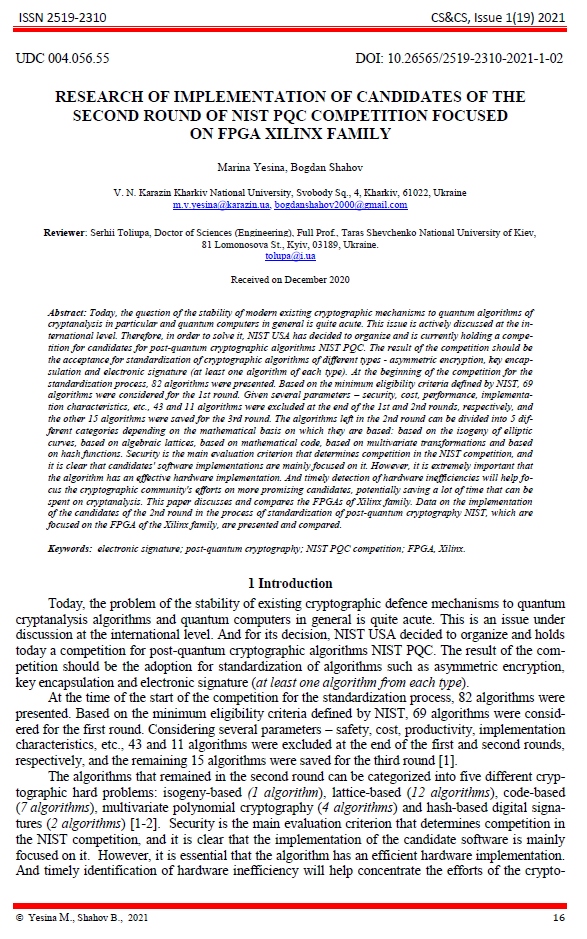Research of implementation of candidates of the second round of NIST PQC competition focused on FPGA Xilinx family
Abstract
Сьогодні досить гостро постає питання щодо стійкості сучасних існуючих криптографічних механізмів до квантових алгоритмів криптоаналізу зокрема та квантових комп’ютерів взагалі. Ця проблема активно обговорюється на міжнародному рівні. Тому, задля її вирішення, NIST США вирішив організувати та проводить на сьогоднішній день конкурс на кандидатів на постквантові криптографічні алгоритми NIST PQC. Результатом конкурсу повинне стати прийняття до стандартизації криптографічних алгоритмів різного типу – асиметричне шифрування, інкапсуляція ключів та електронний підпис (як мінімум по одному алгоритму з кожного типу). На момент початку конкурсу на процес стандартизації було представлено 82 алгоритми. На основі критеріїв мінімальної прийнятності, визначених NIST, для 1-го раунду було розглянуто 69 алгоритмів. Враховуючи декілька параметрів – безпеку, вартість, продуктивність, характеристики реалізації тощо, 43 і 11 алгоритмів були виключені при завершенні 1-го і 2-го раундів відповідно, а інші 15 алгоритмів були збережені для 3-го раунду. Алгоритми, які залишилися у 2-му раунді можна розділити на 5 різних категорій залежно від математичного базису, на якому вони засновуються: на основі ізогеній еліптичних кривих, на основі алгебраїчних решіток, на основі математичного коду, на основі багатовимірних перетворень і на основі геш-функцій. Безпека є основним критерієм оцінки, що визначає конкуренцію в конкурсі NIST, і, зрозуміло, що реалізації програмного забезпечення кандидатів в основному зосереджені на ній. Однак, вкрай важливо аби алгоритм мав й ефективну апаратну реалізацію. А своєчасне виявлення апаратної неефективності допоможе сконцентрувати зусилля криптографічної спільноти на більш перспективних кандидатах, потенційно заощадивши велику кількість часу, що може бути витрачена на криптоаналіз. У даній роботі розглядаються та порівнюються між собою FPGA сімейства Xilinx. Наводяться та порівнюються між собою дані щодо реалізацій кандидатів 2-го раунду в процесі стандартизації постквантової криптографії NIST, що орієнтовані на FPGA сімейства Xilinx.
Downloads
References
J.-S. Coron, A. Joux, Cryptanalysis of a provably secure cryptographic hash function, Cryptology ePrint Archive Report 2004/013, 2004. http://eprint.iacr.org/2004/013
Post-quantum cryptography, round 2 submissions. [Електронний ресурс]. – Режим доступу: https://csrc.nist.gov/projects/post-quantum-cryptography/round-2-submissions.
Malik Imran A Systematic Study of Lattice-based NIST PQC Algorithms: from Reference Implementations to Hardware Accelerators / Malik Imran, Zain Ul Abideen, Samuel Pagliarini //. – Режим доступу: https://arxiv.org/pdf/2009.07091.pdf.
Viet Ba Dang Implementation and Benchmarking of Round 2 Candidates in the NIST Post-Quantum Cryptography Standardization Process Using Hardware and Software/Hardware Co-design Approaches / Viet Ba Dang, Farnoud Farahmand, Michal Andrzejczak, Kamyar Mohajerani, Duc Tri Nguyen, Kris Gaj //. – Режим доступу: https://eprint.iacr.org/2020/795.pdf.
И. Тарасов ПЛИС Xilinx и Цифровая обработка Сигналов Особенности, преимущества, перспективы. – Режим доступу: https://www.electronics.ru/files/article_pdf/2/article_2788_434.pdf.
Xilinx. 7 Series Product Selection Guide. [Електронний ресурс]. – Режим доступу: https://www.xilinx.com/support/documentation/selection-guides/7-series-product-selection-guide.pdf.
Farnoud Farahmand et al. Software/Hardware Codesign of the Post Quantum Cryptography Algorithm NTRUEncrypt Using High-Level Synthesis and Register-Transfer Level Design Methodologies. In: 29th International Conference on Field Programmable Logic and Applications, FPL 2019. Barcelona, Spain: IEEE, Sept. 2019, pp. 225–231. ISBN: 978-1-72814-884-7. DOI: 10.1109/FPL.2019.00042.
Kris Gaj Challenges and Rewards of Implementing and Benchmarking Post-Quantum Cryptography in Hardware. In: 2018 Great Lakes Symposium on VLSI, GLSVLSI 2018. Chicago, IL, USA: ACM Press, 2018, pp. 359–364. ISBN: 978-1-4503-5724-1. DOI: 10/ggbscs.
Jens-Peter Kaps et al. Lightweight Implementations of SHA-3 Candidates on FPGAs. In: 12th International Conference on Cryptology in India, Indocrypt 2011. Vol. 7107. LNCS. Chennai, India, Dec. 2011, pp. 270–289. ISBN: 978-3-642-25577-9 978-3-642-25578-6. DOI: 10.1007/978-3-642-25578-6_20. – Режим доступу: https://2011.indocrypt.org/slides/gurung.pdf.
Viet B Dang et al. Implementing and Benchmarking Three Lattice-Based Post-Quantum Cryptography Algorithms Using Software/Hardware Codesign. In: 2019 International Conference on Field Programmable Technology, FPT 2019. Tianjin, China: IEEE, Dec. 9-13, 2019, pp. 206–214. DOI: 10.1109/ICFPT47387.2019.00032.


